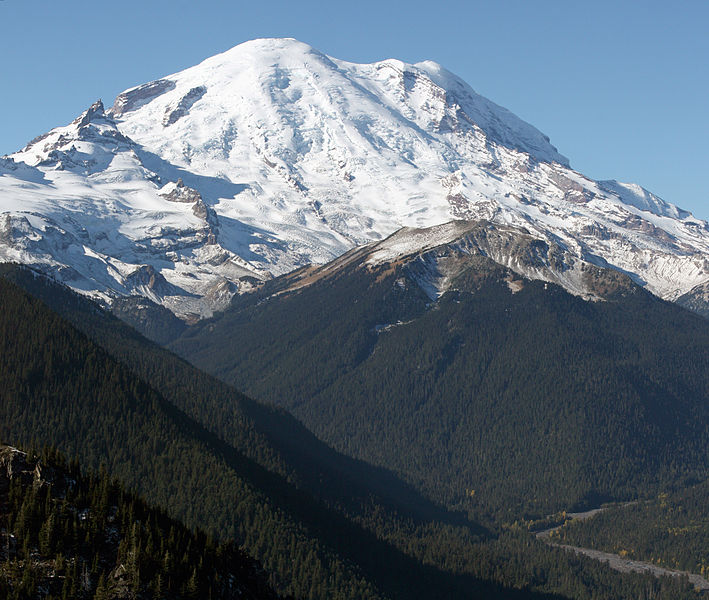5 December 2012
Glacial quakes mask those warning of volcanic eruptions
Posted by kramsayer

Glaciers on volcanoes like Mount Rainier generate swarms of low magnitude earthquakes that can be confused with those that often precede volcanic activity. (Credit: Walter Siegmund/Wikimedia Commons)
Swarms of tiny, repeating earthquakes often precede volcanic unrest, as they did prior to the 1989 eruption of Alaska’s Mount Redoubt. New research at Mount Rainier in Washington state finds that glaciers produce similar low magnitude seismic shocks that are not predictive of volcanic activity, and that could be interfering with efforts to predict when a dangerous eruption is imminent.
Because Mount Rainier is a glacier-covered volcano located near population centers, an eruption there could trigger hot mudflows that would endanger tens of thousands of people.
“We need to monitor volcanoes to know what’s going on, but we also have to be able to tell the difference between these glacial quakes and the precursor volcanic quakes,” said Kate Allstadt, a seismology doctoral student at the University of Washington in Seattle.
Allstadt presented the new findings by her and her colleagues Tuesday at the American Geophysical Union’s Fall Meeting in San Francisco.
Models have previously shown that a large eruption of Mount Rainier could send a torrent of scorching mud the consistency of wet concrete rumbling down the mountain’s northwest side and into the Puyallup River Valley toward Puget Sound. Such an event could imperil the 150,000 residents who live in communities built on top of previous mudflows and produce up to $40 billion in damage, according to a 2012 Washington state Department of Natural Resources report.
In 2010, Allstadt and her colleagues first observed what initially looked like swarms of precursor earthquakes on Mount Rainier. Each swarm consisted of hundreds to thousands of regularly spaced events – up to 40 per hour. These quakes measured too low on the Richter scale to be felt by people, nor were they easily distinguished by eye on seismographs.
By subsequently scrutinizing 10 years of records from Mount Rainier, the researchers found dozens of swarms. “They happened every single year and only during winter,” said Allstadt.
She next looked at data from a weather station on Mount Rainier, and found that swarms of seismic activity occurred one or two days after storms dumped a few feet of snow.
“The seasonality and correlations with weather make it pretty clear that [the earthquakes] are glacial and not volcanic,” said Allstadt.
“It’s kind of strange that such a small amount of snow could change glacier behavior,” she added. As far as she knows, the behavior has not been reported previously. She is currently working with glaciologists to study the mechanism, but speculates that snow may press down, causing small periodic slips at the bed of the glacier.
Allstadt statistically analyzed the Mount Rainier data to define the ‘normal’ level of glacier-generated swarm activity. She has since set up a website to detect deviations from this baseline in the real-time data coming from the mountain’s seismic stations. Such deviations might correlate with volcanic activity, especially if no heavy snowfalls precede the swarm. She thinks similar setups, with the potential to become warning systems, could monitor other glaciated volcanoes in the Cascade Range.
– Chris Palmer is a science communication graduate student at UC Santa Cruz










 GeoSpace is a blog on Earth and space science, managed by AGU’s Public Information staff. The blog features posts by AGU writers and guest contributors on all sorts of relevant science topics, but with a focus on new research and geo and space sciences-related stories that are currently in the news.
GeoSpace is a blog on Earth and space science, managed by AGU’s Public Information staff. The blog features posts by AGU writers and guest contributors on all sorts of relevant science topics, but with a focus on new research and geo and space sciences-related stories that are currently in the news.